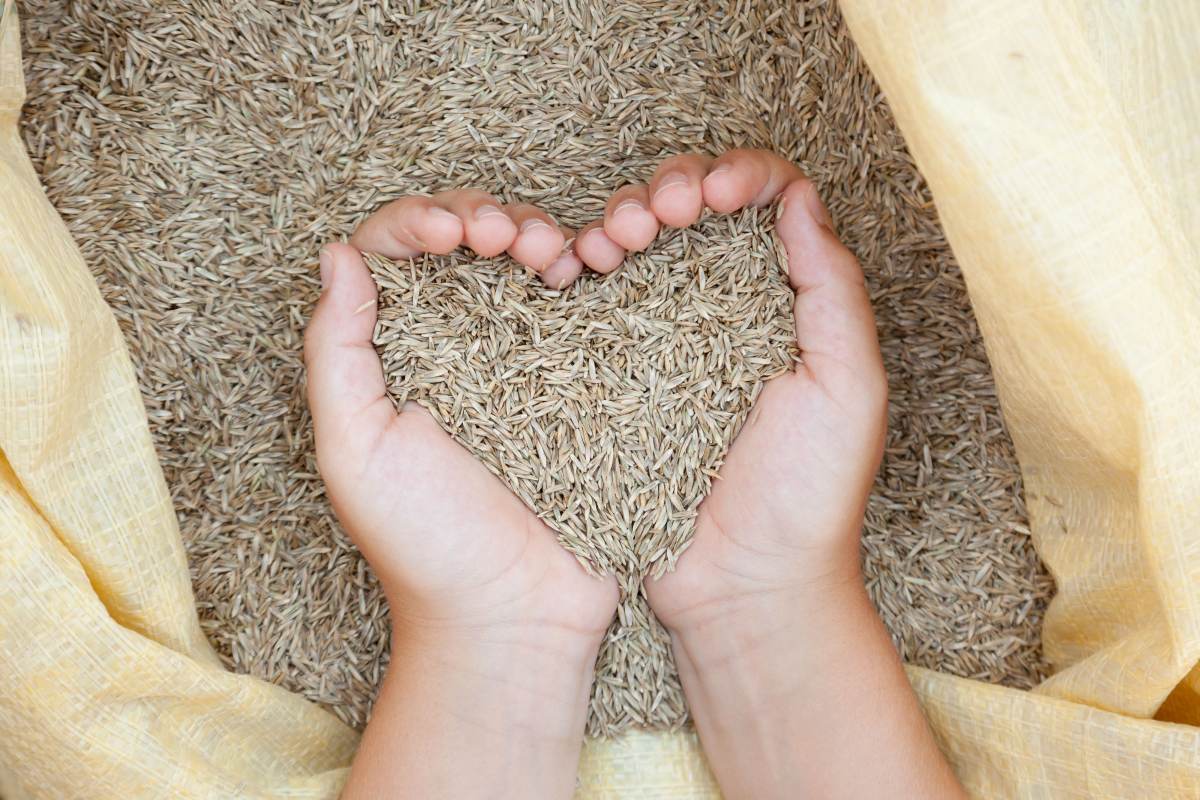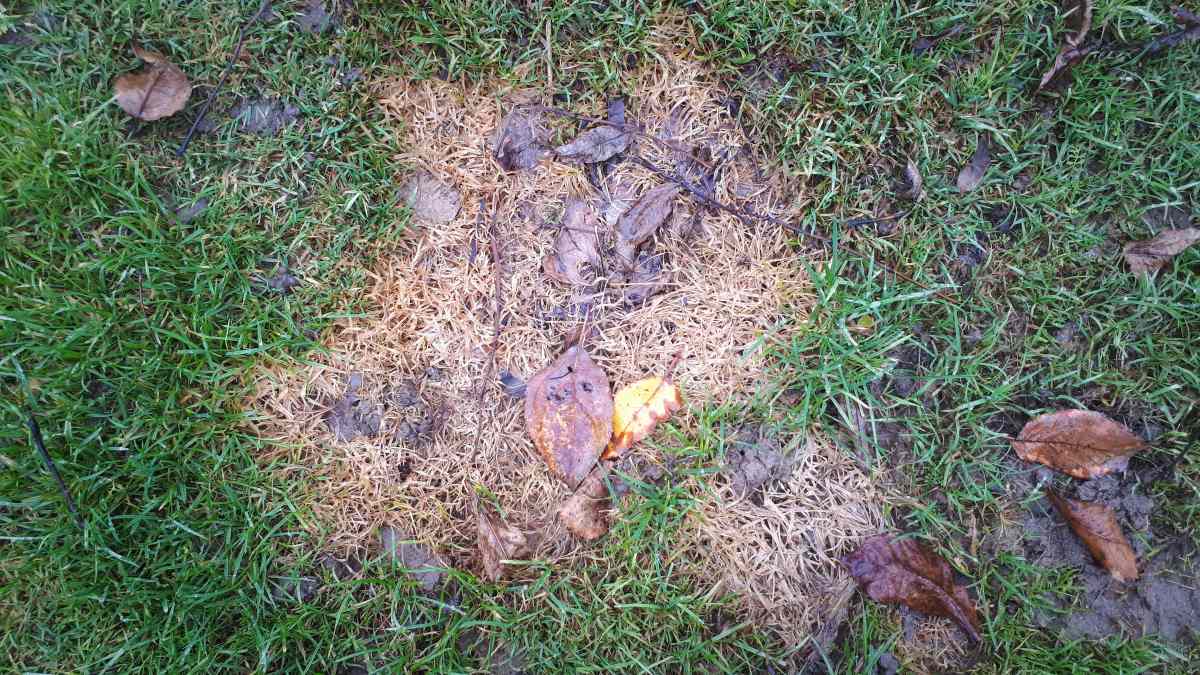
If the thought of maintaining a living, breathing slice of earth turns your cheeks green, you’ve come to the right place. Whether you’re a new homeowner or you haven’t had the time to get your hands dirty, our guide to lawn care for beginners offers easy-to-follow tips.
What time of year should you fertilize your lawn? What tools should you store in your garden shed or garage? We’ve got the answers to green up your lawn and your green thumb.
Get ready to have the best lawn on the block. Here’s what we’ll cover in this beginner’s guide to lawn care.
- 1. Say Hello to Your Soil
- 2. Identify Your Grass
- 3. Fertilize Your Turf
- 4. Prevent Bald Patches
- 5. Rev Up the Mower
- 6. Water Wisely
- 7. Aerate the Soil
- 8. Dethatch the Lawn
- 9. Pests and Fungi 101
- 10. Combat Lawn Weeds
- 11. Rake Autumn Leaves
- 12. Know Your Tools
- 13. Mind the Environment
- Show Your Lawn Some TLC
- FAQ: Lawn Care for Beginners
1. Say Hello to Your Soil
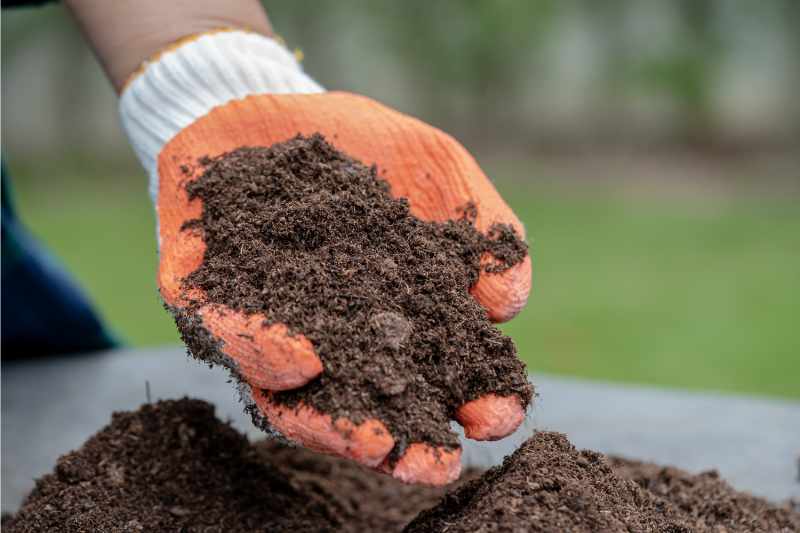
Soil isn’t just a mound of dirt from which grass magically springs. The health of your soil has a significant impact on the health of your turf. If your soil is low in nutrients and organic matter, then your turf will struggle to grow without the help of fertilizers.
Soil texture also impacts yard care. For example, clay soils retain water much better than sandy soils, which means you won’t have to water a clay lawn as often. So before you start making decisions about your lawn care routine, you need to get to know your soil. How do you do that? By conducting a soil test, of course!
A soil test uncovers many mysteries about your soil, including:
- Fertility levels
- Salt levels
- Organic matter percentage
- pH levels
- Texture (relative proportions of sand, silt, and clay)
At-home soil tests are available, but they do not provide as detailed results as a soil test performed in a laboratory.
Most at-home soil tests will reveal your soil’s basic nutritional levels, but these tests don’t usually provide information on fertilizing the lawn and applying soil amendments. On the other hand, a laboratory test usually reveals the best fertilization regimen for your turf and how to improve your soil’s overall health.
Your local university or Cooperative Extension may offer laboratory soil testing. Check the website or call to learn how to prepare and ship a soil sample to the office.
How Often Should You Test Your Soil?
Test your soil once every three years.
2. Identify Your Grass

Grass is grass, right? Well, not quite. There are many types of grass, and each one requires a different level of care. Some grass types will thrive in your region’s climate, while others will struggle to survive. Grass species fall into two categories: cool-season grasses and warm-season grasses.
Cool-season grasses grow best in Northern states, where winters are long and summers are mild. Cool-season grasses actively grow in spring and fall when temperatures are low. They enter dormancy in the summer and frigid periods of winter.
Cool-season grasses include:
- Tall fescue
- Fine fescue
- Kentucky bluegrass
- Bentgrass
- Perennial ryegrass
- Annual ryegrass
Warm-season grasses grow best in the Southern states, where summers are long and winters are mild. Warm-season grasses prefer warm temperatures and actively grow in summer. In autumn, warm-season grasses enter dormancy when temperatures drop below 65 degrees and green up again in spring.
Warm-season grasses include:
But what if you live smack dab in the middle of the country? This area is the transition zone, with scorching summers and frigid winters. You can grow either type of grass in the transition zone.
Here’s what we mean: In the transition zone, if you have a green lawn in summer, your lawn has warm-season grass. If your lawn is brown in summer, it’s growing cool-season grass.
3. Fertilize Your Turf

Before you go spreading fertilizer willy-nilly, refer to your soil test results to choose the right fertilizer.
Your lawn requires three essential nutrients to thrive:
- Nitrogen (N)
- Phosphorus (P)
- Potassium (K)
Results from a lab soil test will often recommend an N-P-K ratio that’s best for your soil. Most fertilizers will list the N-P-K ratio on the label. If a fertilizer package lists the numbers 25-10-15, that means the fertilizer contains 25% nitrogen, 10% phosphorus, and 15% potassium. You’ll also need to choose liquid or granular fertilizer.
How Often Do You Need to Fertilize Your Lawn?
A healthy, established lawn can thrive with just one fertilizer application per year. However, if your soil has poor fertility, a soil test may recommend multiple applications. You don’t need “lawn care for dummies” to spread fertilizer. Like many other essential lawn care tools, all you need is the right equipment.
When is The Best Time to Fertilize Your Lawn?
Cool-season grasses: If you’re growing cool-season grass, the best time to fertilize your lawn is in the fall. Spring is the second-best time to fertilize cool-season grasses.
Warm-season grasses: The best time to fertilize warm-season grasses is mid-spring through summer.
Lawn care tips:
- When fertilizing in spring, wait until your lawn has greened up. Otherwise, the turf will sacrifice healthy root growth for leaf growth.
- Never mow right after fertilizing the lawn. If you need to mow and fertilize the same day, mow first and then wait a few hours before applying fertilizer.
4. Prevent Bald Patches

Your neighbor’s lawn is always dense and green, while yours looks patchy and thin. What’s their secret? They’ve probably been overseeding their lawn.
Overseeding is the spreading of grass seed over an existing lawn to encourage new growth. The secret is to overseed before patches form rather than after to prevent patches in the first place.
When Should You Overseed Your Lawn?
Overseed your warm-season lawn in spring or early summer. If you’re growing cool-season grass, overseed your lawn in the fall.
How Often Should You Overseed Your Lawn?
If your lawn is susceptible to thinning or you have a high-traffic yard, overseed once a year. If your lawn maintains its fullness with ease, overseed every few years.
5. Rev Up the Mower

Cutting your grass might seem like lawn care 101, but there’s a right and wrong way to do it. We’ll show you how to mow your yard the right way:
Keep the Blades Sharp
You wouldn’t cut your hair with blunt kitchen scissors, right? Well, you shouldn’t cut your grass with a dull mower blade either. Mowing with dull blades not only rips your grass and makes the lawn look untidy, but it also makes your grass vulnerable to pests and diseases.
Sharpen lawn mower blades at least once a year to ensure a healthy, crisp cut.
Don’t Mow Too Low
Every grass type has a recommended mowing height (that’s why it’s so important to identify your grass type). If you mow below your grass’s recommended mowing height, you’ll scalp the lawn. Scalping stresses your turf and makes it vulnerable to pests and diseases.
But remember, you don’t want to let your grass grow too high either. Pests and fungi love the moist environment tall grass creates.
Follow the Rule of One-Third
This rule is pretty simple: Never mow more than one-third of your grass’s height in a single mow. For example, if your grass is 3 inches tall, don’t cut off more than 1 inch. Otherwise, you’ll harm your turf.
Mow Before Winter
As winter approaches, you may notice your lawn’s growth slowing down. Once your grass stops growing, give it one last mow before winter arrives. If you let your lawn enter winter with tall grass, your turf may attract pests and diseases, especially snow molds. And who wants mold in their yard?
6. Water Wisely

Poor watering habits can prove detrimental to your lawn’s health. But if you keep the following irrigation tips in mind, your lawn’s health will be right on track:
- How much to water? Most established lawns need 1 to 1.5 inches of water per week, depending on the grass type.
- Water your lawn before 8 a.m. Watering in the morning gives your lawn plenty of time to absorb the water before it evaporates in the afternoon sun.
- Avoid watering in the evenings. The evening might seem like a good time to water because the sun won’t be coming out, but the lawn still needs the sun to help it dry. Otherwise, the water will cling to the grass blades throughout the night, which creates a moist, attractive environment for pests and diseases.
- Water your lawn less often and for long periods to promote a deep, healthy root system. Watering too often and for short periods encourages a shallow, weak root system. How often should you water? It’s recommended to water your lawn deeply once a week.
- Pay attention to signs of thirst. If your turf turns grayish-blue or your footprints are visible on the lawn, then your grass needs a drink.
Pro Tip: If you don’t want to wake up at the crack of dawn to water your lawn, consider installing an automatic sprinkler.
7. Aerate the Soil

Aeration might sound like a spa treatment, but that’s because it is one – for your lawn. Aeration relieves compact soil and allows your turf’s roots plenty of access to water, oxygen, and nutrients.
An aerator is a tool you push similar to a lawn mower. The core aerator pulls small plugs of soil from the ground to create holes in the lawn. The holes allow water, oxygen, and nutrients to reach the roots. When soil becomes too compact, it’s almost as if your lawn’s roots can’t breathe, drink, or eat.
Don’t have an aerator? Your local home improvement store may offer hourly, daily, or weekly equipment rentals.
When is the Best Time to Aerate Your Lawn?
Warm-season grasses: The best time to aerate warm-season grasses is in summer.
Cool-season grasses: The best time to aerate cool-season grasses is in fall.
How Often Should You Aerate Your Lawn?
Most lawns need aeration once every year, especially lawns with clay soil. If your lawn has sandy soil or is performing well, aerating once every three years is enough. For other factors affecting frequency, check out When and How Often Should You Aerate Your Lawn?
8. Dethatch the Lawn

Thatch is the layer of dead and living organic matter that accumulates between the soil’s surface and the grass blades (it’s kind of like dandruff on your scalp but on your lawn). Like aeration, thatch removal is a part of basic lawn care.
A thin layer of thatch is healthy for your lawn, and you don’t have to remove it. A thatch layer of less than one-half inch acts as a mulch for the grass. But once the thatch layer becomes one-half inch thick, it’s time to remove it.
Excessive thatch is attractive to pests and diseases and prevents water and fertilizer from penetrating the soil. Therefore, you should keep an eye out for the signs of excessive thatch.
How to Dethatch Your Lawn
If your lawn has excessive thatch, push a dethatcher across the yard to remove the thatch. Dethatcher rentals are often available at home improvement stores. You can also hire a lawn care company to do the work. The average cost of dethatching by a pro is between $160 and $225, depending on the size of your lawn.
When Should You Dethatch Your Lawn?
Warm-season grasses: The best time to dethatch warm-season grass is late spring through early summer.
Cool-season grasses: Fall is the best time to dethatch cool-season grass.
9. Pests and Fungi 101

Pests and diseases love weak, poorly maintained lawns. Tall grass, moist environments, thick thatch — these are recipes for fungus, lawn diseases, and bugs. Yuck! If your lawn shows signs of uninvited guests, identify the culprit and execute a control method right away.
Signs of pests and diseases include:
- Visible fungus, mildew, or mushrooms growing on the lawn
- Discoloration of the turf, such as brown spots
- Discoloration of individual turf blades, like with leaf spot
- Dead or dying patches of grass
Many preventative and curative chemical treatments are available for pests and fungi, but the best treatments are often improved lawn maintenance. If pests and diseases are a recurring problem, your yard may have an underlying health issue that needs attention.
10. Combat Lawn Weeds
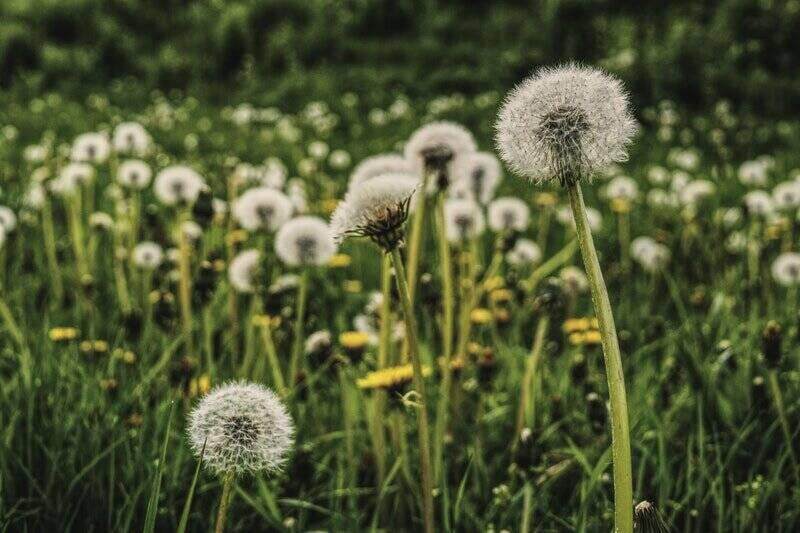
If weeds are taking over your lawn, you may have made your lawn inviting by letting your lawn care slide. Weeds have an easy time invading weak lawns, but healthy lawns stand taller and stronger against the interlopers. You can read your weeds and discover underlying issues.
When weeds are a constant issue in your lawn, combine improved maintenance practices with a pre-emergent herbicide or post-emergent herbicide.
- Pre-emergent herbicide acts as a barrier that blocks weed growth. Use pre-emergents to prevent weed establishment on your lawn.
- Post-emergent herbicide kills existing weeds on contact. It’s recommended to apply post-emergents when the weeds first start sprouting up.
If you’re interested in organic herbicides, there are natural weed killers available that you can make at home for DIY lawn care. No matter which option you choose, always read the label to ensure you’re getting the best weed killer for your lawn.
11. Rake Autumn Leaves

As the leaves pile up in your yard, it’s tempting to ignore them, but a thick layer of leaves on the lawn isn’t good for your grass. You should remove leaves from your lawn every few days in the fall, but remove them more frequently if the layer of leaves is wet or suffocating your grass. Here’s why:
- A thick mat of leaves, especially if they are wet, will invite pests and diseases.
- The grass will struggle to photosynthesize without access to sunlight and will eventually die.
Pro Tip: Make your job easier by using a leaf blower instead of a rake. Or, spare your back and schedule professional leaf removal.
12. Know Your Tools
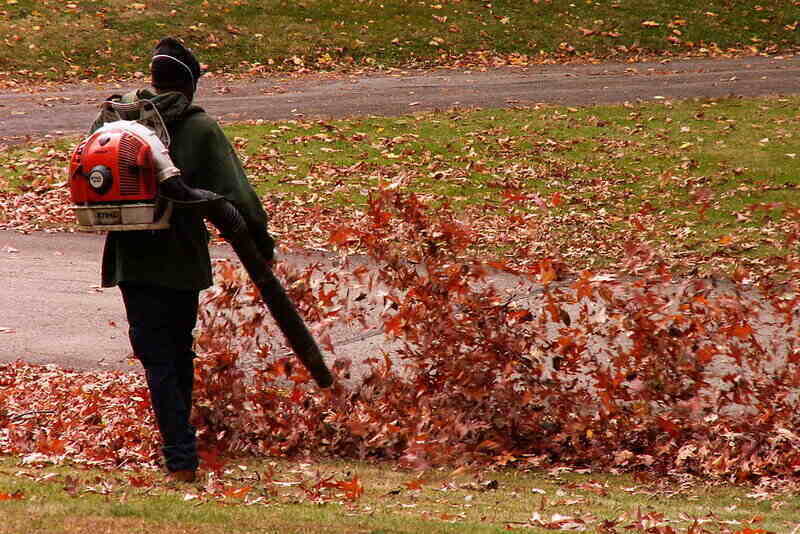
Keeping your grass well maintained requires a few lawn care tools. For beginner lawn care, the main cost of lawn maintenance is the equipment. A lawn mower and leaf rake are essential to have in your shed or garage. Here are a few other pieces of lawn care equipment to consider adding to your tool shed or garage:
- Leaf blower: Uses fast-moving air to help collect fall leaves. A leaf blower can be electric or gas powered.
- Leaf blower vacuum: Sucks up leaves and collects them in an attached bag. Most leaf blower vacuums have a built-in mulcher.
- Weed eater: Trims grass in areas your lawn mower can’t reach. Other names for this lawn care tool include a weed whacker (or weed wacker), string trimmer, or strimmer.
- Spreader: Used to spread fertilizer over a lawn, spreaders can be broadcast, drop-style, or handheld.
- Edger: Available as manual and motorized tools. Using an edger creates distinct lines and boundaries along walkways and flower beds.
- Bow rake: Levels out piles of soil, mulch, and gravel. The best garden rakes will be durable and comfortable to use.
- Wheelbarrow: A wheelbarrow is used for carrying heavy loads across a lawn, such as fertilizer, mulch, or gravel.
- Shovel: For gardens and landscaping, you’ll need a shovel to dig large holes in the ground, and they are useful for collecting soil.
- Garden hose: Watering the lawn and nearby flower beds is easier with a sturdy garden hose.
When shopping for lawn care tools, consider what power source you’d like to use. Take your pick among gas-powered, corded electric, or battery-powered tools.
- Gas-powered tools provide the most horsepower, but they’re harmful to the environment.
- Corded electric tools are eco-friendly and affordable, but your work area is limited by the length of your power cord.
- Battery-powered tools are eco-friendly and not restricted to a power cord, but they require frequent charging.
13. Mind the Environment

As you learn more about lawn care, it’s easy to get carried away with fertilizer, pesticides, and herbicides. But these chemical products aren’t good for the environment, and it’s best to limit their use.
A simple way you can increase your lawn’s eco-friendliness is by performing proper maintenance, such as good watering and mowing techniques. The healthier your turf, the less you’ll need to rely on chemical assistance.
Here are some ways you can practice lawn care with the environment in mind:
- Don’t fertilize more than recommended. Using too much fertilizer may harm your grass, and excess fertilizer will wash away and pollute local waterways.
- Install a rain barrel near your gutter system and use the water for irrigation. Harvesting rainwater helps lower your reliance on the local water supply.
- Prevent pests and diseases from invading your lawn with good lawn care practices instead of preventative chemicals. Aeration, dethatching, mowing, and leaf removal are natural ways you can make your yard less attractive to pests and fungi.
- Go organic with fertilizers: If you need to apply fertilizers and pesticides, switch from synthetic products to organic fertilizers.
- Don’t bag your leaves or grass clippings. Bagging and throwing away yard debris takes up space in landfills and removes nutrients from the environment. Leave your grass clippings on the lawn and shred your leaves to make a mulch (or compost them).
Show Your Lawn Some TLC
DIY lawn care isn’t rocket science, and it needn’t be intimidating. Maybe you’ve never tested your soil before, or perhaps you need to learn more about your grass type — that’s OK.
It takes time to get to know your lawn. Make a note of which treatments your lawn needs yearly and which ones can wait. Every lawn is different, so remember to store a little patience in your tool kit (for yourself and your turf).
FAQ: Lawn Care for Beginners
Why Bother With Weed Control?
Not only do weeds lower curb appeal, but they also compete with your grass for space, sunlight, nutrients, and water. If a weed invasion gets out of hand, it may eventually crowd out your grass.
Common lawn weeds include:
- Crabgrass
- Nutsedge
- Dandelions
- Quackgrass
How Do You Plant Grass Seed?
Planting grass seed is a relatively simple process; it just requires preparation.You’ll need to:
- Remove existing grass
- Perform a soil test
- Select and plant your grass seed
- Provide plenty of water and TLC
Check out How to Plant Grass Seed in 6 Steps for a step-by-step guide.
What is Xeriscaping?
Xeriscaping is a landscaping technique that focuses on water conservation. It involves using drought-tolerant plants, efficient irrigation systems, and other strategies to create a low-water garden or landscape. Xeriscaping aims to reduce water usage while still maintaining an aesthetically pleasing outdoor space.
When to Call a Lawn Care Pro
Whether you’re a first time homebuyer or you’ve enjoyed the same yard and home for years, tending to your lawn for hours in the sun might be the last thing you want to do.
So let our lawn care experts take care of your yard for you. Hire a local lawn care professional who will mow, fertilize, and aerate your lawn. Who says you can’t have a healthy, beautiful lawn without lifting a finger? (Well, you do have to lift your finger to click a link or call to book your lawn care services, but that’s it.)
Main Photo Credit: Skitterphoto / Pixabay

